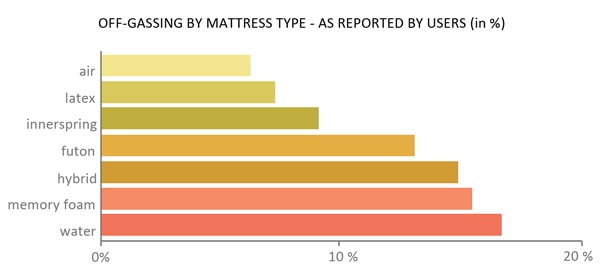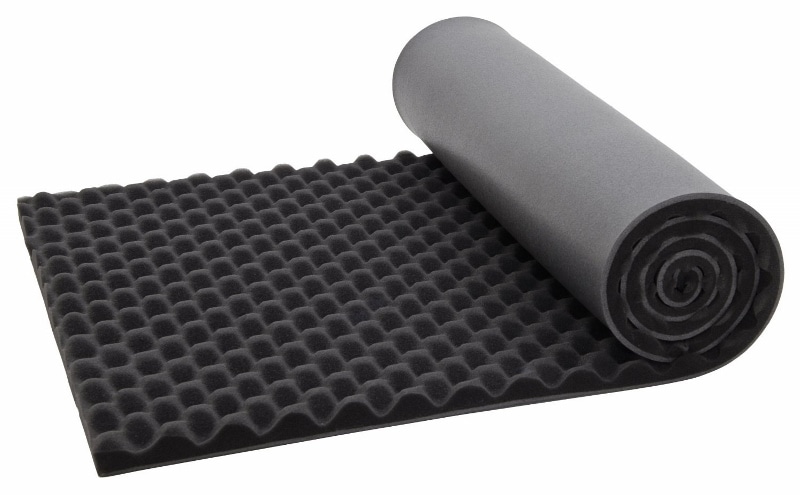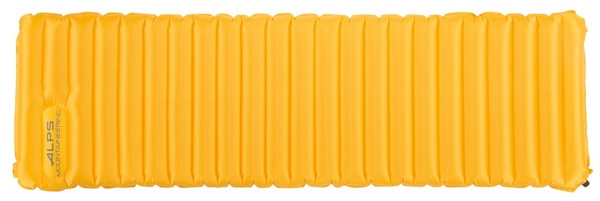This guest post was written by James over at 3Beds.com and talks in great details what you need to look for when buying an air mattress, foam pad and/or sleeping pad.
I’m waking up. It’s a crisp March morning in one of the campsites on Cumberland Island. My hips and shoulders are aching like I’m 105.
My wife is stirring up two mugs of that instant coffee on a small blue stove. She is chattering on about wild horses and turtles. I wish she’d stop.
My eyelids weigh a ton.
I hate that instant coffee.
That stove is much too slow, we should’ve got a new one years ago.
Thought after thought, I’m finding new ways to think about everything that’s wrong with this trip…
And let me tell you – it takes a lot of negativity not to appreciate the sight of wild horses gracefully strolling on the soft beaches of Cumberland.

I am generally a very positive person and I couldn’t figure out what’s wrong with me…not until a few days into the trip, at least.
After 5 or 6 miserable mornings, it hit me – it was the sleep, or the lack of it, to be more precise.
It was my terrible sleeping pad that’s ruining what should be one of the most relaxing hikes you can get in the US.
You were probably wondering what I’m going on about and this is it – my point is that how you sleep can make or break a trip.
I learned a lot about choosing the right air mattress/sleeping pad since and this guide is about making sure you avoid the “Cumberland Island” experience.
So, let us get to the “meat” of the guide…choosing the best inflatable mattress / pad and waking up with that refreshing feeling only a night of being sound asleep can give you.
Contents
Air mattress or sleeping pad?
This choice is pretty intuitive and it’s hard to choose wrong but let’s go over the basics.
When to go with an air mattress
When space and time allow…this usually means car-camping.
An air mattress, of course, is the superior choice in terms of comfort and the home-like feel but it’s also big and heavy.
Bottom line – not something you want in your backpack.
But, if you are going with an air mattress for your tent, let’s go over a few rules of thumb of choosing the best inflatable:
Chambers – the more, the merrier
Chambers of an air mattress distribute weight much better than the old-school horizontal or vertical beams. These air mattresses are also the most comfortable, the most durable and best-suited for every-day use. Just head over to any online retailer, find one of each and compare the reviews of the airbeds. You’ll understand what we’re talking about.
What it means for you – it means no sinking to the middle of the bed, longer lifespan of your mattress and no sore muscles or a stiff neck.
Safety – Let us bust one myth here.
An air mattress is followed by the suspicion of not-being safe because of the plasticky smell that often lingers for days with a new airbed.
Nobody can precisely define it, but the feeling is there.
First of all, the “dangerous” kind of PVC that stamped the airbed as being somewhat of a health hazard isn’t used anymore by any of the best air mattress brands.
Let’s be very precise about this – the fumes of a mattress are called off-gassing and an air mattress is by far the safest options when it come to this.
Take a look at the following graph:

Second – if you want to make sure you are extra safe, look for a “BPA-free” or “phthalate-free” in the specs of the materials. You even have the option of choosing an air mattress that’s completely PVC-free.
Back in the day when there was some truth to the claims about health risks of an air mattress, these were the chemicals that were the usual suspects.
Few simple rules of thumb can make all the difference in avoiding sleep deprivation on multi-day adventures.
Battery and hand operated pump – most of the modern air mattresses feature an electric pump. If you are planning to take yours out to the trail, choose one that features a pump that can be battery operated.
If it’s a longer trip – go with an airbed that can fit a nozzle of a manual pump.
Now that we have our basics of choosing an air mattress down let’s get to what’s probably more interesting for most adventurers…
Choosing the right sleeping pad
There are more moving parts to choosing a sleeping pad then an airbed, but it all comes down to a few simple principles.
Let’s get right to it…
The infamous R-value
Probably the one piece of information that’s most widely misunderstood and it’s not a surprise, the information that’s out is often conflicting and confusing.
Let’s make it right…
What is it?
Ranging from 1-9.5, an R-value of a sleeping pad is just a way of telling you how good the insulation of the pad is. The R comes from heat flow Resistance.
Which one should I go with for the temperatures I’m expecting?
This is the missing piece of the puzzle because the companies will rarely list how R-value relates to temperatures.
That’s why we did a bit of research of our own across dozens of brands and 100s of products that do list R-value and temperature ratings.
The following table is a fruit of that research:

Do the R-values of multiple items add-up?
Yes.
The sleeping arrangement will most often include a foam mat and/or a sleeping bag/pad.
If you have two items with an R-value of 3 the total R-value is approximately 6.
Some of the energy does get lost when doubling up, that’s why we stressed the “approximately.”
If you have to mix and match, having the thicker item (bag, pad) on top is a better idea.
Making it simple
There’s too much fuss about the R-value of sleeping pads, so let’s make it really simple.
The sweet spot of R-values is in the span of 3.5-4.5. The pads that fall into this range are most versatile, meaning that they’d be a good fit in most scenarios.
If you read that a sleeping pad is a 4-season, chances are, its R-value is somewhere in this range.
The ones with the lower R-value are suited for warm nights while the pads that go over 5 are generally not a good fit for backpacking. They’re heavy, bulky and used for extreme cold (see the table) or car-camping.
The basic types of sleeping pads
Reason suggests that we should’ve addressed this one first because it’s a basic. But it’s also pretty straightforward and anybody with any experience sleeping outdoors understands what’s what here.
Nonetheless, let’s go over the basic types of pads
Strictly speaking, there is two basic types of sleeping pads – the foam mats and the inflatable beds.
Speaking less strictly, there are three, because a few years back one of the companies came to the market with a self-inflatable pad and today, most of the brands have lines of these.
Foam mats (closed-cell)
The cheapest, lightest and the most durable option but hardly a good choice when used on its own.

Combine it with an air pad / sleeping bag and you have your perfect setting for the night.
Best use – combined with at least an air pad.
Obviously, it can’t be deflated. It’s rolled or folded and strapped to the side of a backpack.
Air pads
PVC or textile pad that inflates manually, which is not a big deal because you can blow it up in about 1 minute. The more sophisticated models feature an integrated pump – you press it and when you let go it sucks air into the pad.
They pack very small – there are air pads out there that pack to the size of a soda can.
Mind. Blown.

But again, not the best option on its own because it’s very prone to punctures and, what’s more important, if it’s punctured and you can’t fix it, it becomes a piece of useless plastic.
Best use – combined with at least a foam mat.
Self-inflatables
No pumping, no batteries…these babies inflate on their own.
How?
The technology is called open-cell foam. The inside of the pad is filled with foam (open-cell). The air from the foam cells is squeezed out as you pack the pad and sucked back in when you unwrap it and open the valve.
Even when the material is punctured, there’s still the foam so, unlike a regular air pad, it’s not just a piece of plastic and can still be used even when punctured.
Nifty little things with a few hiccups, the main being the fact that they simply change over time and the self-inflation doesn’t work quite as well after, let’s say, a year.
The cells of the foam deform and can’t take in as much air as they used to.
They also don’t pack as small as an air pad (because of the foam inside), but the fancier ones still pack small enough to be a viable choice for a backpack (about the size of a football).
Other than that, probably the most hassle-free choice.
Width and length
Making the lightest pad is all the rage these days and that often means sacrifices, both in terms of insulation and comfort. Unless you’re an ultra-light hiker, most of the time it’s not worth it.
Ask yourself – do I want my feet hanging for 8 hours just so that my backpack is a few oz. lighter?
So, for a truly comfortable sleep make sure the pad:
- Is long enough to accommodate your feet
- Is wide enough to comfortably accommodates your shoulders’ width
This especially goes for women and cold sleepers.
Another thing a woman adventurer should consider is extra insulation (width) at the hips. Pads that come in what’s called a tappered or a mummy design are extra wide at the hips and best-suited for women hikers/adventurers.
Weight
We analyzed what were the most popular and the best-rated air pads and most of them fall into the weight range of 0.8 – 3 range.
It seems to be the range where the companies can offer the best insulation/size ratio.
Note: there is a relation between the weight and the durability of a pad. It’s an inversely-proportional one, naturally. In plain terms, the lighter the pad, the worse the idea of having it in direct contact with the ground.
To wrap it up
In Dirt Farmer Wisdom, Jo Jo Jensen said, “Without enough sleep, we all become tall two-year-olds.” We all know it takes a grown up to respond to the challenges Mother Natures puts in front of us on that trail. So, be the grown up, be smart and sleep well.
If this guide helps in any way, I’ll be sleeping better tonight.
